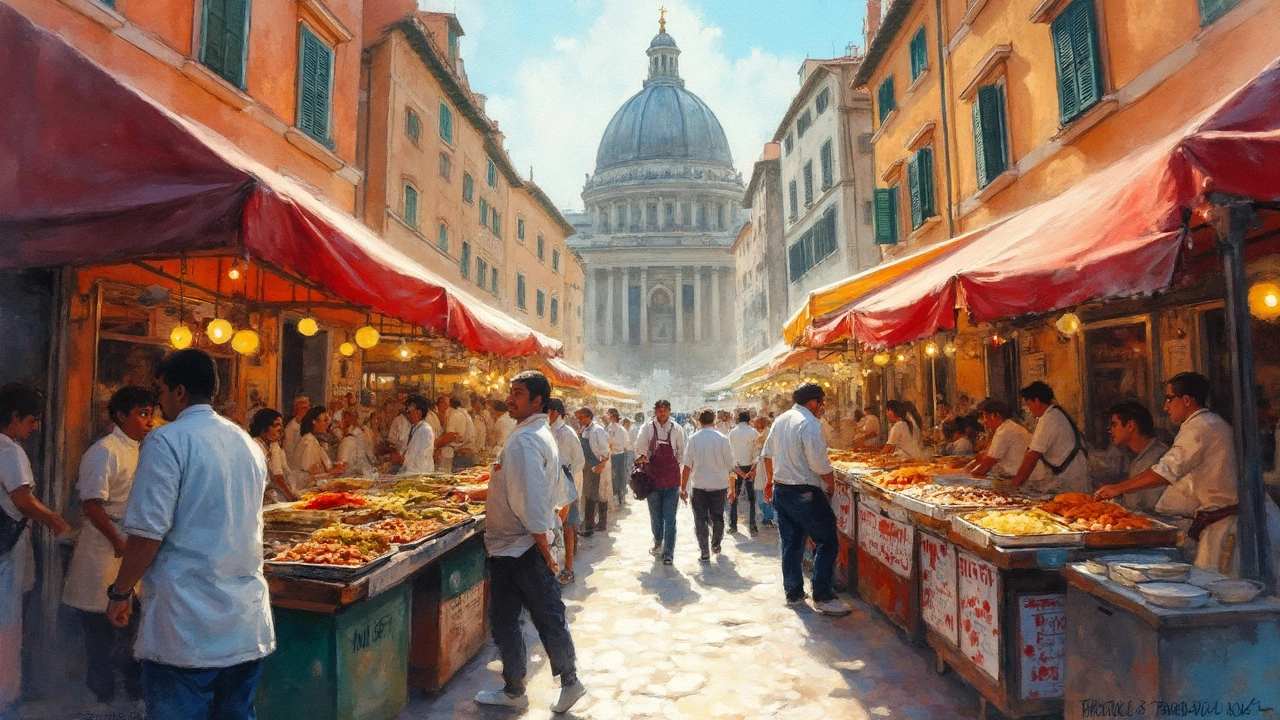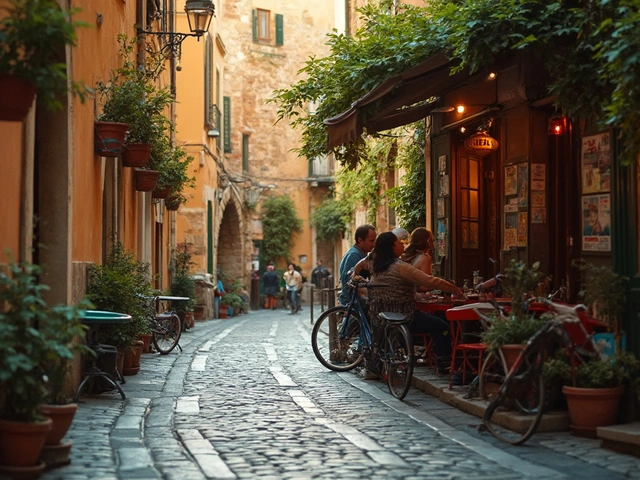
Ever felt like you were just following the herd in Rome, standing in long lines and snapping the same photos as everyone else? You’re not alone. Rome’s full of jaw-dropping sights, but there’s a smarter way to see the city. No one wants to spend half their trip shuffling behind crowds at the Colosseum or paying triple for a pizza in a touristy square.
The good news? Rome rewards people who show a little curiosity. Spots like the Aventine Keyhole let you peep through to St. Peter’s Dome with zero crowds. There are little churches with hidden Caravaggio paintings just lying in wait, free and uncrowded. And if you're starving, the best carbonara doesn’t come from the places with English menus out front—it hides in tiny trattorias where old men play cards at lunch.
You don’t need to be a Rome expert or even speak much Italian to get a more local vibe. A couple of smart tips go a long way here—like booking museum tickets online (seriously, do it), or grabbing an early breakfast in Testaccio before the market stalls burst to life. All it takes is a bit of planning, and Rome opens up in ways you never expected.
- Skip the Crowds: Smart Sightseeing Moves
- Eat Like a Local: Food Worth Finding
- Hidden Corners: Underrated Spots in Rome
- Beneath the Surface: Underground Rome
- Beyond the City Walls: Easy Unusual Day Trips
Skip the Crowds: Smart Sightseeing Moves
Getting stuck in long lines isn’t why you came to Rome, right? Let’s make your sightseeing smooth and actually fun. Start by timing your visits. Big hitters like the Colosseum and Vatican Museums fill up fast. Go early, as soon as the gates open, or late in the afternoon just before they close. The bulk of the tour groups hit midday, so dodging those time slots is your first win.
Don’t just show up and hope for the best. Buying tickets online for the Colosseum, Vatican, or Borghese Gallery is like having a cheat code—head straight to the security line, not the ticket counter. For the Borghese, you even have to pre-book a slot. You’d be shocked how many people still don’t do this and end up waiting under the Roman sun for hours.
Want a view without people leaning over your shoulder? Skip the mob at Piazza di Spagna and check out the rooftop terrace at Rinascente. Order a coffee, and soak in skyline views without elbowing kids with gelato. For a different kind of wow, the Aventine Hill’s Orange Garden, or ‘Giardino degli Aranci’, gives you sweeping city views and it’s rarely crowded—plus, it’s totally free.
- St. Peter’s Basilica: Security can get wild. Go at 7am right when doors open, or come after 5pm. Sundays usually mean lighter lines.
- Roman Forum & Palatine Hill: You don’t have to enter at the Colosseum. Try the lesser-used entrances at Via di San Gregorio for quicker access.
- Pantheon: It’s now ticketed after 2023 changes. Reserve online and aim for a late-afternoon slot (fewer tour groups, easier photos).
Most people hit the same handful of famous churches, but there are dozens with art and history and no crowds. For example, head to San Luigi dei Francesi near Piazza Navona. It’s home to Caravaggio masterpieces and you’ll sometimes have it almost to yourself—best part, it’s free.
| Top Attraction | Best Time to Visit | Online Ticket Required? |
|---|---|---|
| Colosseum | 8:30am or after 4pm | Yes |
| Vatican Museums | 7:30am or Fri/Sat evenings | Yes |
| Borghese Gallery | Late morning weekdays | Yes (pre-reserved slot) |
| Pantheon | After 4pm | Yes (small fee) |
Strolling streets like Via dei Coronari or exploring Trastevere in the morning means fewer tourists and better photos, too. Rome travel tips don’t get simpler: beat most folks out of bed, click ‘buy’ on those tickets, and you’ll get way more out of every hour in this city.
Eat Like a Local: Food Worth Finding
If your idea of eating in Rome is crowded restaurants near the Trevi Fountain, you’re missing out. The real magic? It’s in the backstreets and neighborhoods locals actually visit. Seriously, skip those laminated menus. If you want real things to do in Rome that’ll stick in your memory, focus on food that Romans brag about to each other.
Let’s start with a breakfast move. Order a coffee at the bar—standing up. It costs less than sitting down, and you’ll blend right in. Pick a spot like Sant'Eustachio Il Caffè, with beans roasted on-site for almost a century. Grab a cornetto (Italy’s answer to a croissant), and you’re set to start your day the local way.
Now, pasta. There’s a lot of hype, but three pasta dishes really matter: carbonara, cacio e pepe, and amatriciana. Head to Trastevere’s Da Enzo (come early—there’s always a line), or Armando al Pantheon if you want classic Roman flavors and not a tourist circus. These places aren’t cheap, but locals celebrate birthdays here for good reason.
For something fast—and totally Roman—look for supplì (fried rice balls, usually stuffed with ragù and mozzarella) or pizza al taglio (pizza by the slice). Bonci Pizzarium near the Vatican turns out slices topped with everything from potato and rosemary to porchetta. It’s not fancy. Grab a slice, eat it on the curb, people-watch. You’ll see actual Romans doing the same.
- Want a sit-down meal nobody talks about? Try Testaccio. This area’s full of family-run spots serving up coda alla vaccinara (braised oxtail) and trippa alla romana (Roman-style tripe) that have been on the menu for decades.
- For gelato, don’t get sucked in by neon colors or huge piles. Real gelaterias—like Fatamorgana or Gelateria del Teatro—make smaller batches and use seasonal flavors. If the banana gelato is grayish, not yellow, you’ve found the good stuff.
Here’s a tip: Tipping isn’t expected, just round up your bill or leave a few coins. Locals never leave 20% like in the States, and staff won’t expect it.
| Neighborhood | Must-Try Food | Local Favorite |
|---|---|---|
| Testaccio | Coda alla vaccinara | Felice a Testaccio |
| Trastevere | Carbonara | Da Enzo al 29 |
| Centro Storico | Supplì | Supplizio |
| Prati | Pizza al taglio | Bonci Pizzarium |
When you focus on these real eats, a trip to Rome hits way different. You’ll avoid tourist traps, eat better, and maybe pick up a little Italian along the way. That's how locals do it—and now, so can you.

Hidden Corners: Underrated Spots in Rome
You’ve probably heard a million times about the Trevi Fountain and the Spanish Steps, but there are way better spots if you want a real taste of Rome without the endless crowds. If you want things to do in Rome that most people miss, this is your shortcut.
Kicking things off is the Coppedè District. Tucked away in northern Rome, it covers just a few blocks but the buildings look like something straight out of a fantasy movie. You’ll find Art Nouveau mixed with medieval turrets—and almost zero tourists. Don’t skip the creepy-cool entrance arch; it’s one of a kind.
Want an unbeatable view for your Instagram without hundreds of heads in the shot? Head to the Orange Garden (Giardino degli Aranci) on Aventine Hill. It’s totally free and gives you a killer sunset over the city, plus the keyhole at the nearby Priory of the Knights of Malta. Peek through it to spot St. Peter’s framed perfectly—hardly anyone lines up in the early morning.
The Basilica di San Clemente is like time traveling without a ticket. On street level it looks like a regular (pretty) old church, but spend a few euros and head beneath the surface. You’ll walk through three layers of history: a twelfth-century basilica, a fourth-century church, and then a first-century Roman house complete with an ancient temple to Mithras.
Dreaming of peace and quiet? The Protestant Cemetery (Cimitero Acattolico) near Testaccio is more uplifting than you’d expect. Some famous English writers like Keats and Shelley are buried here, but the cat colony and crazy old mausoleums steal the show. It never gets overrun.
For something odd but totally Roman, try Centrale Montemartini. This place is basically an old power plant stuffed with marble statues from the Capitoline Museums. Ancient art plus giant turbines = weird, but it works. Entry is cheaper than most museums and you usually have the place to yourself.
- Rome travel tips: Most of these places don’t need reservations. Show up early or in late afternoon for the quietest vibes.
- Maps might not always show the best routes—Coppedè and the Orange Garden are easiest to reach by bus or taxi.
- The Basilica di San Clemente is open from 9am to noon and again from 3pm to 6pm. Save a few euros for the underground part—it’s worth it.
Try at least one of these Rome hidden gems for stories and photos way better than the usual tourist fare. It’s way more fun slipping into a spot the guidebooks barely mention.
Beneath the Surface: Underground Rome
People think they know things to do in Rome—ancient ruins, fountains, pizza in the sun. Not many realize the coolest stuff is actually below their feet. Seriously, Rome is like Swiss cheese: packed with tunnels, crypts, even whole buried neighborhoods. This isn’t just old bricks and bones—it’s the other side of the city, way out of the typical tourist loop.
Start with the Catacombs. These ancient underground burial sites near the Appian Way stretch for miles. The Catacombs of San Callisto and San Sebastiano are the most famous—you’ll see narrow passages lined with simple graves (and some seriously impressive frescoes), not to mention a real-life look at Christian history before it went mainstream. Heads up: the air is chilly and you’ll climb stairs, so wear good shoes and bring a light jacket even in summer.
If you want something even wilder, go for the Basilica di San Clemente. From the street, it looks like a regular old church. Step inside, though, and you’ll descend three levels down through time—first to a medieval church, then an ancient Roman building, and finally a pagan temple. Some of these spots are over 2,000 years old. You’ll literally walk through history, floor by floor.
For pure eeriness, check out the Capuchin Crypt on Via Veneto. It’s decorated with the bones of over 3,000 monks—think chandeliers made of vertebrae, walls lined with skulls. It sounds macabre, but it’s weirdly fascinating. And unlike the jam-packed Vatican, you’ll rarely have to jostle with big crowds here.
- Book popular underground tours online ahead of time. Tickets can sell out, especially for the Catacombs and San Clemente.
- Most underground sites don’t allow big bags or flash photography—travel light and charge your phone for photos where allowed.
- No need to hire a pricey guide for every crypt. Many have cheap audio guides or signage in English.
If you’re really into quirky Rome hidden gems, peek at Vicus Caprarius (the "City of Water"). It hides near the Trevi Fountain and shows off what’s left of an ancient Roman apartment block and water system. A lot of locals haven’t even heard of it. Entrance is cheap, and you’ll dodge crowds while learning how ancient plumbing shaped the city we see today.
Quick stat check? There are over 60 known catacomb networks beneath Rome, with more than 150 kilometers of tunnels mapped so far.
| Underground Spot | Known For | Location |
|---|---|---|
| San Callisto Catacombs | Christian burial tunnels | Via Appia Antica |
| San Clemente Basilica | Layers of history (church, Roman house, temple) | Via Labicana |
| Capuchin Crypt | Bones and eerie art | Via Veneto |
| Vicus Caprarius | Ancient Roman neighborhood and aqueduct | Near Trevi Fountain |
If you want Rome local experiences people actually brag about, the underground is it. You’ll see a raw, untouched side of the city most tourists totally miss.

Beyond the City Walls: Easy Unusual Day Trips
If you’ve already ticked off the usual things to do in Rome, it’s time to hop a train or bus and shake things up. Rome’s trains can get you out of the city fast, and you don’t have to be a local to figure them out. Here’s a quick guide to quirky and rewarding places that aren’t all over Instagram (yet).
- Ostia Antica: This ancient port city is only half an hour from the city by metro and local train. Think of it as a mini Pompeii—with fewer crowds, crumbling streets you can actually walk, and old mosaics just sitting out in the open. You’ll get a real feel for daily Roman life, minus the chaos.
- Tivoli: Everyone raves about the Villa d’Este’s gardens and fountains, but the real stunner nearby is Hadrian’s Villa. This spot was Roman emperor Hadrian’s version of a mega-mansion getaway. Public buses will take you there for cheap, and you can sprawl out on ancient marble benches dreaming you’re an emperor.
- Lago di Bracciano: Trains from Rome bring you to this deep-blue volcanic lake in under an hour. The cute town of Bracciano has a castle you can actually go inside. Romans love grabbing lake fish for lunch and just chilling by the water—no loud tour groups, barely any hassle.
- Calcata: This tiny village, carved into a cliff above the Treja River, looks like a movie set. Artists set up shop in weird caves, and the whole place feels like you stumbled into a secret world. Get there by bus from Saxa Rubra station; it’s worth the extra effort just for the lunch spots hidden in winding alleys.
If you want some numbers on how much locals love getting out of town, check this out:
| Day Trip Destination | Avg. Travel Time (One Way) | Entry Cost |
|---|---|---|
| Ostia Antica | 35 min | €18 |
| Tivoli | 55 min | €13 (Villa d’Este), €12 (Hadrian's Villa) |
| Lago di Bracciano | 50 min | Free to access lake, €9 for castle entry |
| Calcata | 1 hr 15 min | Free to enter village |
Trains and buses leave from main stations like Termini and Tiburtina. You don’t need a car, and planning is simple—just double-check the last train times. Rome’s surrounded by gems that most tourists miss, but Italians know better. Don’t let your trip end at the city limits.



